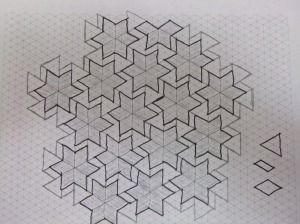I saw this blog article about a 6 pointed star quilt with an unusual setting. I found it as intriguing as the writer. The author and commenters were wondering how to make the quilt. Here’s my drawing of a portion of the quilt on isometric graph paper.
I hope you can see the grid lines on the graph paper. There are 3 different shapes in the quilt. One for the stars and two for the background.
Each star is made up of six 60 degree diamonds. Each diamond is 2 units per side.
The background triangles are 3 units on each side.
The background parallelogram is 2 units by 1 unit.
The three shapes are drawn separately on the right side of the graph paper.
Now that you know how the pieces fit together, you can choose any size you want for the unit. For example, you might decide that you want 1 unit = 1 inch. In that case, the diamonds would be 2″ on each side, the triangles would be 3″ on each side and the parallelogram would be 2″ by 1″. These are the finished sizes of the pieces. They don’t include the seam allowance.
Once you’ve chosen your unit size, you can draw your templates on graph paper. Don’t forget to add the 1/4″ for the seam allowance to each side of the template.
I printed my graph paper from Impetech. I set “line weight” to .05 and “triangle side length” to .25. For drawing the templates, I would set the triangle side length to the size of my unit to make it simple. Using the example above, that would be 1″. I would draw the finished piece first then draw the seam allowance around the template.
I hope that all makes sense.

August 24, 2013 at 5:30 am |
Hello Barbara,
What a nice surprise to find your comment on my article. And how wonderful to read your entry on your blog. It makes it all very clear. Thank you very much. I am really thinking of making ( a portion of) this quilt. Now, I only have to figure out how to sew the pieces together. I am not a hand sewer. I like to piece everything on my machine. That will be a big challenge. But I like this quilt so much, that I might even try hand sewing the whole thing. But then it will not be a big quilt! Is’n it nice to be part of a global quilting society!
Happy quilting,
Marina.
August 26, 2013 at 4:53 pm |
I’m glad I could help. Hand piecing or English paper pieceing are certainly the traditional ways to do it. It could be machine sewn in rows if you did some of the diamonds as two triangles instead of a diamond. It would have to be laid out on a design wall in order to get everything in the correct place. � Barbara Bennett, Columbia, MD
>________________________________
August 26, 2013 at 2:20 pm |
That is an intriguing quilt. Your explanation of the sizes, particularly for the parallelogram, is helpful.
August 26, 2013 at 4:53 pm |
Thanks. I’ve been a student of Jinny Beyer since 1997. She stresses drafting skills. This one was pretty easy to work out. I’ll have to make one of these one day. � Barbara Bennett, Columbia, MD
>________________________________